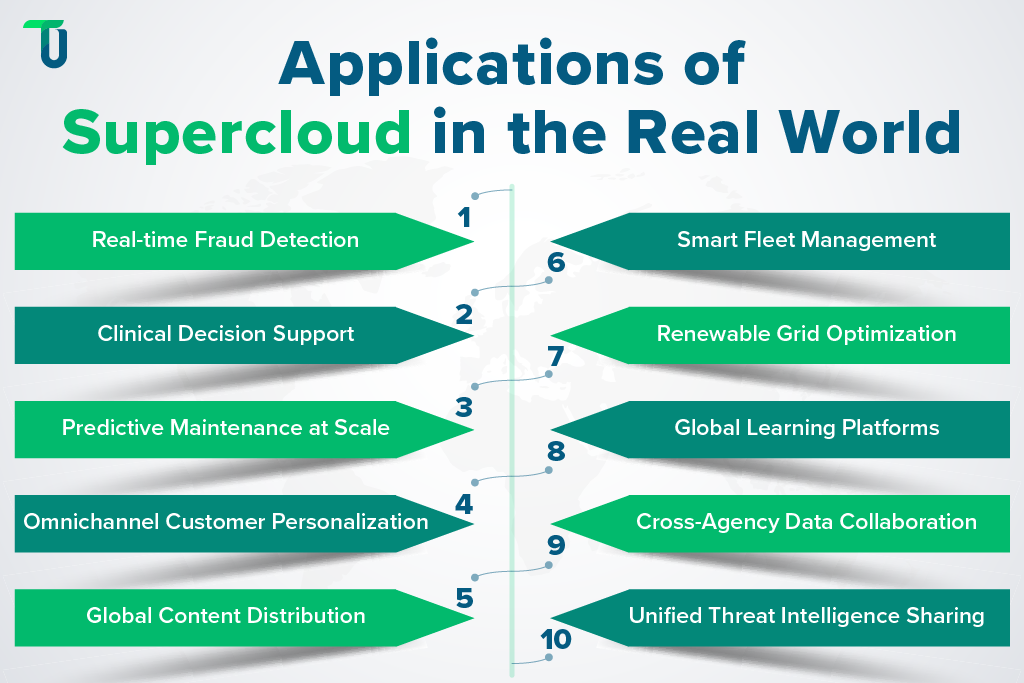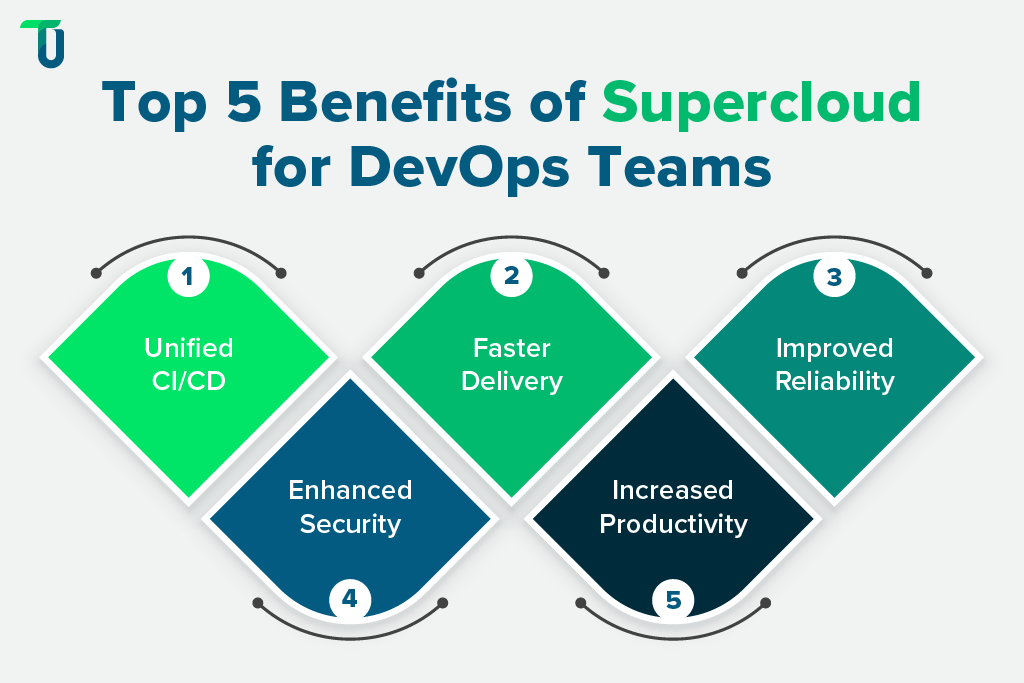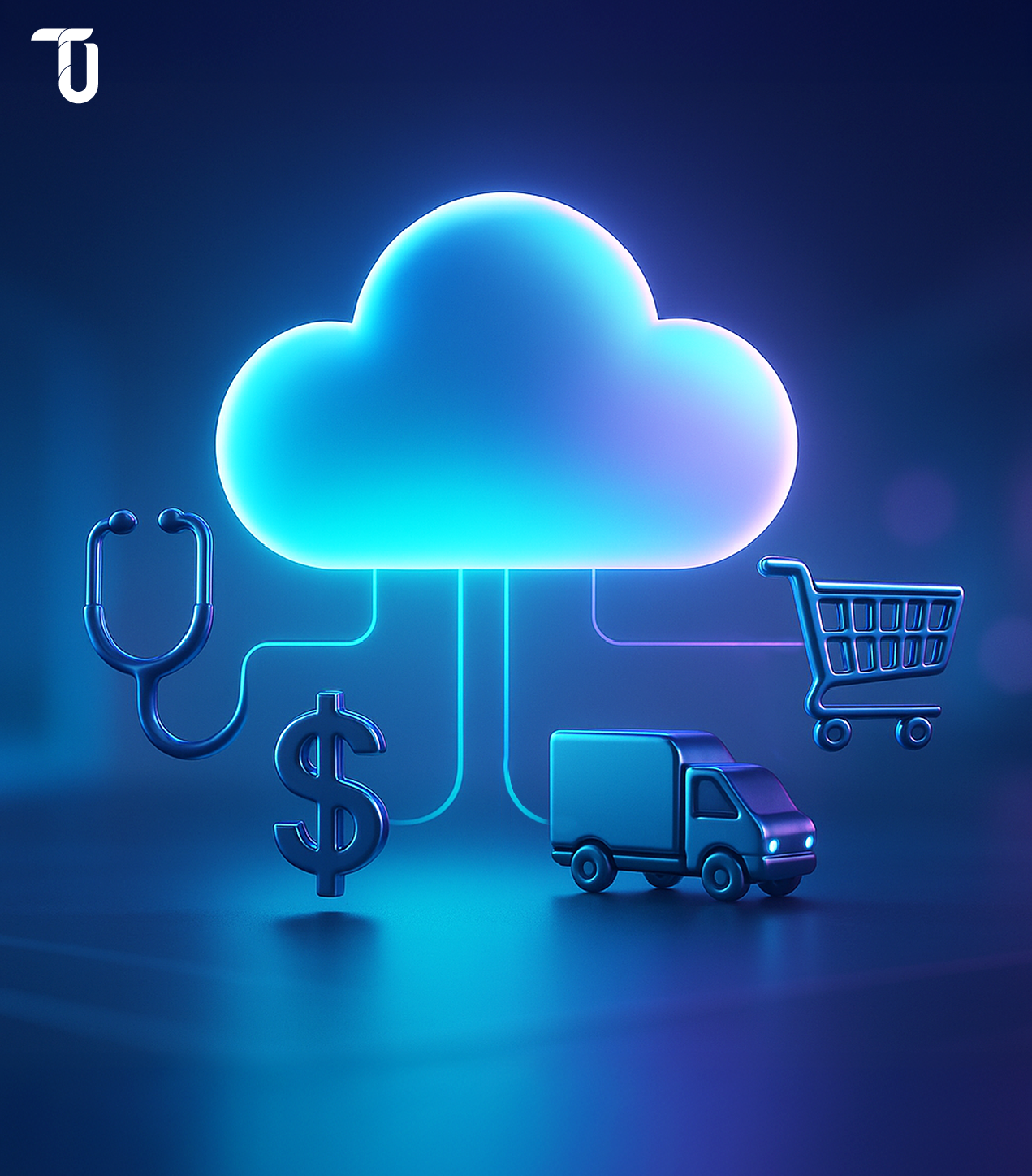Use Case 1: Financial Services – Real-time Fraud Detection
One of the most powerful supercloud use cases in 2025 appears in financial services, where banks and fintech companies handle a massive number of transactions every second. These transactions come from mobile apps, online portals, ATMs, and more.
With such a large volume of data spread across regions, traditional systems often face delays in detecting fraud. Supercloud architecture solves this by allowing real-time analytics on distributed data without moving it around.
By using AI supercloud, companies can place fraud detection models closer to where the data exists. This helps systems catch unusual behavior instantly and respond without delay.
Benefits of Real-time Fraud Detection with Supercloud
- Detects fraud as it happens by analyzing data instantly in a multi-cloud setup.
- Stops suspicious activity before it causes damage or financial loss.
- Handles sensitive data securely while following global compliance standards.
All in all, supercloud gives financial companies faster, smarter, and safer ways to fight fraud.
This is just one example of how Supercloud is changing the game. To understand the broader shift it represents in enterprise computing, check out our deep dive on why Supercloud is a paradigm shift in cloud computing.

Use Case 2: Healthcare – AI-Powered Clinical Decision Support
Another key supercloud use case in 2025 is in healthcare. Hospitals and clinics often store patient data across different systems, some on local servers and others in the cloud. This setup makes it hard for doctors to access complete records during urgent care.
Supercloud connects these systems without shifting data. It links on-premise records with cloud-based AI tools to support better decisions. Moreover, supercloud also allows federated learning, so hospitals improve accuracy without sharing data.
Benefits of Clinical Decision Support with Supercloud
- Improves diagnosis accuracy by combining local and global data through AI supercloud.
- Helps doctors plan treatments faster with real-time access to insights.
- Enables global medical research while protecting patient data and privacy.
To sum up, supercloud makes healthcare smarter, faster, and more connected without risking data security. Partnering with a Healthcare mobile app development company helps hospitals implement secure, patient-centric mobile applications seamlessly.
Supercloud enables organizations to unify and scale workloads seamlessly across multiple cloud environments while maintaining centralized control. For a deep dive into its core architecture, layers, and benefits, see our guide to Supercloud architecture.
Use Case 3: Manufacturing – Predictive Maintenance at Scale
Another notable example of supercloud use cases in 2025 appears in manufacturing. Modern factories use thousands of sensors on machines, robots, and production lines. These sensors collect huge amounts of data every second.
With a supercloud setup, manufacturers can bring all this data together from different global locations without delay. Additionally, the AI supercloud places machine learning models close to the factory floor using edge-cloud integration.
This helps systems predict when a machine might fail, long before it actually does. Repairs can then be planned in advance.
Benefits of Predictive Maintenance with Supercloud
- Prevents downtime by predicting equipment issues before they happen.
- Improves machine performance by planning maintenance at the right time.
- Supports large-scale data from global sites using multi-cloud flexibility.
All in all, supercloud gives manufacturing a smarter way to stay efficient and avoid costly delays.
Many organizations confuse Supercloud with Multi-cloud or Hybrid Cloud, but the differences are significant, especially in integration, scalability, and control. For a clear comparison, see our guide on Supercloud vs. Multicloud vs. Hybrid Cloud.
Plan Your Supercloud Architecture with TenUp
Align supercloud with your IT setup using a custom roadmap designed by TenUp’s experienced cloud architects. Talk to our Cloud experts!
Use Case 4: Retail – Omnichannel Customer Personalization
Retail is one of the most visible supercloud use cases, transforming how brands connect with customers in 2025. Today, shoppers move between websites, mobile apps, and physical stores. To keep up, retailers need a clear view of each customer’s behavior.
Supercloud helps by pulling customer data from all platforms into one place. This creates centralized profiles that show real interests, habits, and purchase history. Besides, with AI supercloud, these profiles become smarter over time.
Moreover, supercloud also keeps everything running smoothly across multi-cloud systems– making the experience feel seamless to the shopper.
Benefits of Omnichannel Personalization with Supercloud
- Builds a single customer view from data spread across devices and platforms.
- Tracks behavior in real time to offer the right product at the right moment.
- Increases customer satisfaction by creating more relevant and timely experiences.
To encapsulate, Supercloud helps retailers understand shoppers better and respond faster across all channels.
Use Case 5: Media & Entertainment – Global Content Distribution
Another key supercloud use case in 2025 is global content distribution. With growing demand for fast, high-quality streaming, media companies need reliable ways to deliver content across regions. Supercloud connects CDNs, clouds, and edge nodes into a unified system. This setup ensures consistent and fast delivery to users worldwide.
With AI supercloud, companies can create auto-scaling pipelines for transcoding and rendering. In fact, nearly 42% of companies already use AI in their cloud setup for complex tasks like security and media rendering. This shows how important smart systems are now.
Benefits of Global Content Distribution with Supercloud
- Delivers high-quality content quickly through connected CDNs and edge locations.
- Adapts to viewer demand with scalable rendering and transcoding across clouds.
- Manages licenses and rights effectively using secure, shared digital platforms.
To sum up, Supercloud helps media companies keep up with global demand for smooth and fast streaming. It reduces delays, improves content quality, and simplifies international rights management.
You May Also Like
Use Case 6: Transportation – Smart Fleet Management
A standout among supercloud use cases in 2025 is smart fleet management. Transport companies track thousands of vehicles across cities and countries. Supercloud helps by pulling real-time data from GPS, fuel sensors, and traffic systems into one place. This gives teams a full view of fleet activity without switching platforms.
Using AI supercloud, route plans update based on live road and fuel data. This helps vehicles avoid delays and reach destinations faster. Supercloud also ensures consistent rules and security across all vehicles, no matter the location.
Benefits of Smart Fleet Management with Supercloud
- Cuts fuel costs by adjusting routes based on live traffic and fuel data.
- Improves delivery time accuracy through smarter, faster route planning.
- Keeps vehicle operations safe with global security and policy enforcement.
In simple words, supercloud gives transport teams the tools to manage large fleets with accuracy and speed. From local trips to cross-border routes, it supports real-time updates, better fuel use, and secure operations.
Use Case 7: Energy – Renewable Grid Optimization
Another major example among supercloud use cases in 2025 is renewable grid optimization in the energy sector. With more homes and industries using solar, wind, and battery power, energy providers need better ways to balance supply and demand.
Supercloud helps by connecting these energy sources through hybrid cloud platforms, making data and control systems work together across locations. Additionally, by using AI supercloud, energy companies can predict power needs based on weather patterns and usage trends. This helps avoid shortages and prevents overproduction.
Benefits of Renewable Grid Optimization with Supercloud
- Improves grid stability by coordinating energy sources across hybrid cloud setups
- Predicts power demand accurately using weather and consumption-based data.
- Supports clean energy goals through smarter and more efficient energy distribution.
As we can see, supercloud gives energy providers the tools to manage renewable energy in smarter ways. It allows faster decisions, reduces waste, and makes clean power more reliable.
Pro Tip: Before starting your supercloud journey, map out all your existing cloud, edge, and on-premise systems. This helps avoid confusion later and makes integration smoother. A clear inventory ensures better planning, fewer errors, and faster deployment when you switch to a supercloud environment.
Use Case 8: Education – Global Learning Platforms
The next major use case of supercloud use cases in 2025 appears in education. As online learning grows, students from different countries need access to the same quality of education.
Supercloud connects global learning systems and helps deliver localized content based on region and language. This creates a shared platform while respecting local needs. With AI supercloud, features like real-time translation and AR/VR classrooms become possible. These tools improve understanding and make learning more interactive.
At the same time, supercloud helps educational platforms follow data privacy laws in different countries, keeping student information safe.
Benefits of Global Learning Platforms with Supercloud
- Offers equal learning access to students across countries and regions.
- Improves reach with content tailored to language, location, and local guidelines.
- Supports interactive learning with scalable tools like AR, VR, and live translation.
All in all, supercloud opens new possibilities for education at a global scale. It helps schools and platforms deliver better learning without borders, delays, or data risks.
Use Case 9: Government – Cross-Agency Data Collaboration
The 9th notable use case of supercloud on our list is cross-agency data collaboration in government. Many public departments still rely on separate, outdated systems. This makes it hard to share information during emergencies or when planning public services. Supercloud architecture solves this by securely connecting siloed systems into a shared environment.
With AI supercloud, departments like healthcare, disaster relief, and transport can access real-time data and work together more effectively. It also supports analytics for testing policies and improving decision-making before real-world rollout.
Benefits of Cross-Agency Collaboration with Supercloud
- Speeds up government services by connecting departments through shared systems.
- Helps agencies make smarter choices with access to real-time data and simulations.
- Improves coordination during crises with faster and clearer data sharing.
To sum up, supercloud use cases in government improve how public agencies plan, respond, and deliver services. It brings faster communication, better teamwork, and stronger results. This eventually makes it a key tool for modern public administration.
Use Case 10: Cybersecurity – Unified Threat Intelligence Sharing
The last notable use case of supercloud on our list is cybersecurity through unified threat intelligence sharing. Today, cyber threats move fast and affect both public agencies and private companies. To stay ahead, organizations need to work together. Supercloud makes this possible by allowing easy sharing of threat data across systems and sectors.
With AI supercloud, threat detection models run across cloud and edge locations in real time. Research shows that by 2026, about 68% of enterprise workloads will run on cloud platforms that have built-in AI. This helps companies detect threats faster and more accurately.
Benefits of Threat Intelligence Sharing with Supercloud
- Detects and shares threats quickly across cloud, edge, and enterprise systems.
- Keeps security tools in sync across multiple environments for faster action
- Builds a collective defense system by linking public and private cybersecurity teams.
To summarize, supercloud gives cybersecurity teams a real advantage in a world full of complex threats. It brings faster response, better coordination, and smarter defenses.
These examples show the transformative potential of Supercloud across industries. If you’re ready to translate these possibilities into reality, our CTO’s Guide to Supercloud Implementation Services offers a practical roadmap to design, integrate, and scale your own Supercloud solutions.
DevOps – Streamlining CI/CD Pipelines Across Supercloud Environments
DevOps teams today face a growing challenge: managing continuous integration and continuous delivery (CI/CD) pipelines across fragmented infrastructure—public clouds, on-premise systems, and edge environments. Supercloud solves this by offering a unified layer that connects these environments seamlessly, enabling consistent automation, faster deployments, and improved visibility across the entire software delivery lifecycle.
With supercloud, development, operations, and security teams no longer need to duplicate tooling or manually configure workflows for each cloud provider — an approach that mirrors the flexibility and scalability goals of modern Fintech cloud infrastructure. Instead, they can define pipelines once and deploy them everywhere—whether it's AWS, Azure, private data centers, or edge locations.
Real-World DevOps Benefits Realized with Supercloud

- Unified CI/CD orchestration: Supercloud allows DevOps teams to manage builds, tests, and deployments centrally across hybrid and multi-cloud systems, eliminating environment-specific silos.
- Faster software delivery: Automated pipelines can run closer to the target environment (including edge nodes), reducing latency and enabling faster rollout of features and patches.
- Improved reliability and rollback: Centralized observability and real-time monitoring in supercloud help detect pipeline issues early and roll back changes instantly across clouds.
- Security and compliance built-in: Supercloud makes it easier to apply consistent policy-as-code, access controls, and auditing across all environments, aligning with global DevSecOps best practices.
- Developer productivity boost: Developers can focus on shipping code rather than debugging cloud-specific deployment errors, improving delivery velocity and reducing friction.
Optimize Your Supercloud Architecture and Deployment with TenUp Software
As discussed in this blog, supercloud is gaining momentum across industries. It not only connects cloud, edge, and on-premise systems, but also supports real-time scalability, security, and control. However, to get the most out of it, you need a solid foundation and a clear strategy. That’s where TenUp’s Cloud Solutions come in.
We are a leading technology partner with expertise in cloud architecture, deployment, and optimization. We help companies like yours design, build, and manage supercloud environments that align with your performance, compliance, and growth needs. From selecting the right infrastructure to setting up CI/CD pipelines and serverless components, we support you at every step.
Schedule a one-on-one consultation with the TenUp team now to assess your current cloud environment, identify gaps, and build a supercloud strategy that perfectly fits your business goals.
Seeking to Build a Future-Ready Supercloud?
Get expert guidance on planning, implementing, and optimizing your Supercloud deployment with our experts’ end-to-end support. Book a free consultation today!
Frequently asked questions
What makes Supercloud different from multicloud and hybrid cloud in real business use cases?
Supercloud unifies app and data management across clouds, edge, and on-premise infrastructure, without silos or context switching. It enables real-time AI, automated workload placement, and centralized governance, unlike multicloud and hybrid setups that rely on fragmented tools.
How is Supercloud improving AI and machine learning deployments across enterprise IT?
Supercloud brings AI models closer to where data lives, such as on edge, cloud, or on-premise, boosting speed, security, and cost-efficiency. It streamlines federated learning, real-time retraining, and compliance without the overhead of traditional cloud setups.
Can Supercloud help with cloud vendor lock-in, and if so, how?
Yes. Supercloud helps avoid vendor lock-in by abstracting cloud infrastructure and enabling seamless workload portability across AWS, Azure, GCP, and private clouds, without major rework or platform-specific dependencies.
What is the role of AI observability and monitoring in Supercloud environments?
In Supercloud, AI observability delivers unified monitoring across clouds, detecting model drift, data anomalies, and performance bottlenecks in real time. This ensures scalable, secure, and reliable AI operations across complex, distributed systems.
How does Supercloud impact DevOps and CI/CD pipelines for cloud-native apps?
Supercloud simplifies CI/CD across clouds and edges by offering centralized control, cloud-agnostic builds, and latency-aware deployments. It accelerates testing, model updates, and microservice delivery, without cross-cloud friction.
What challenges should companies expect when transitioning to a Supercloud architecture?
Companies face challenges, like integrating legacy systems, unifying security across clouds, and rearchitecting apps for distributed environments. Success often requires skilled cloud architects and a strategy for multi-cloud and edge orchestration.
Is Supercloud just a marketing term, or is it solving real-world IT problems today?
While still emerging, Supercloud is solving tangible problems, like siloed data, latency in AI workloads, and compliance risk, across real industries. Its growing adoption among large enterprises and cloud providers suggests it’s far more than hype.

